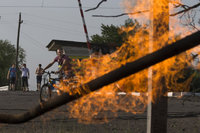Ukraine fiercely bombs Donetsk and Luhansk

Intense fighting continues in Donetsk on July 21. Explosions are heard in the vicinity of the airport and the train station. Black smoke is billowing above the area of the train station, local residents say.
As a result of the shelling, the infrastructure of the Donetsk railway station has been damaged. "A locomotive and railroad tracks are damaged. The work of the train station has been suspended," Interfax reports with reference to the press service of the Ministry of Information of the People's Republic of Donetsk.
A shell hit the market place near the train station. Another shell hit a 9-story building nearby. According to preliminary data, there are victims. Residents are asked not leave their homes.
In addition, according to locals, the town of Avdiyivka, a northern suburb of Donetsk, was attacked as well. Ukrainian troops entered the town.
In the west of Donetsk, there is a tank battle. Shells hit residential buildings. The tanks are trying to make their way from the airport to the railway station.
The city of Luhansk remains under massive artillery fire as well. There is neither electricity nor water supplies in the city. Luhansk is empty. By order of the People's Republic of Luhansk, all roads in Luhansk today are closed, car traffic is completely forbidden.
This measure was enacted for three days "due to the activation of enemy sabotage groups and incessant shelling of Luhansk." Dozens of buildings in the center of Luhansk were damaged as a result of the shelling. Civilians literally have to learn to survive in such circumstances, NTV reports.
Luhansk School No. 7 turned into a bomb shelter on July 21. The walls and ceilings of the building are riddled with shrapnel, all windows are shattered. "When shell splinters hit the building, the people were lying on beds, so the fragments hit the walls, and people were lucky to survive," school principal Victor Zemlyansky says.
From the temple of knowledge, the school has turned into the only place to escape from the Ukrainian artillery. The bomb shelter was built in the 1950s. The school basement was deepened and filled with concrete. Afterwards, it was adapted as a warehouse of school furniture. Today, the basement became the home for about 20 people, mostly women - those who are either afraid to return to their homes, or no longer have homes, where they could return.
Subscribe to Pravda.Ru Telegram channel, Facebook, RSS!




